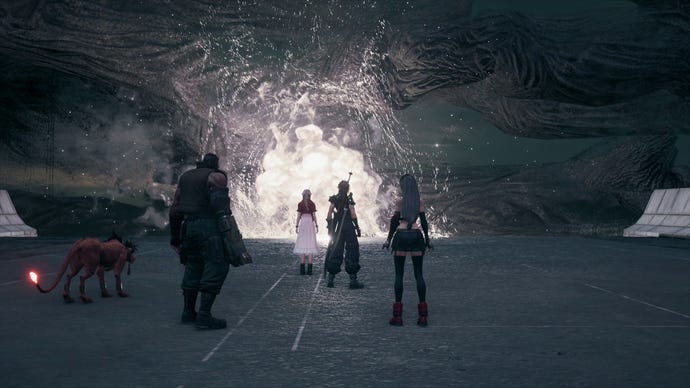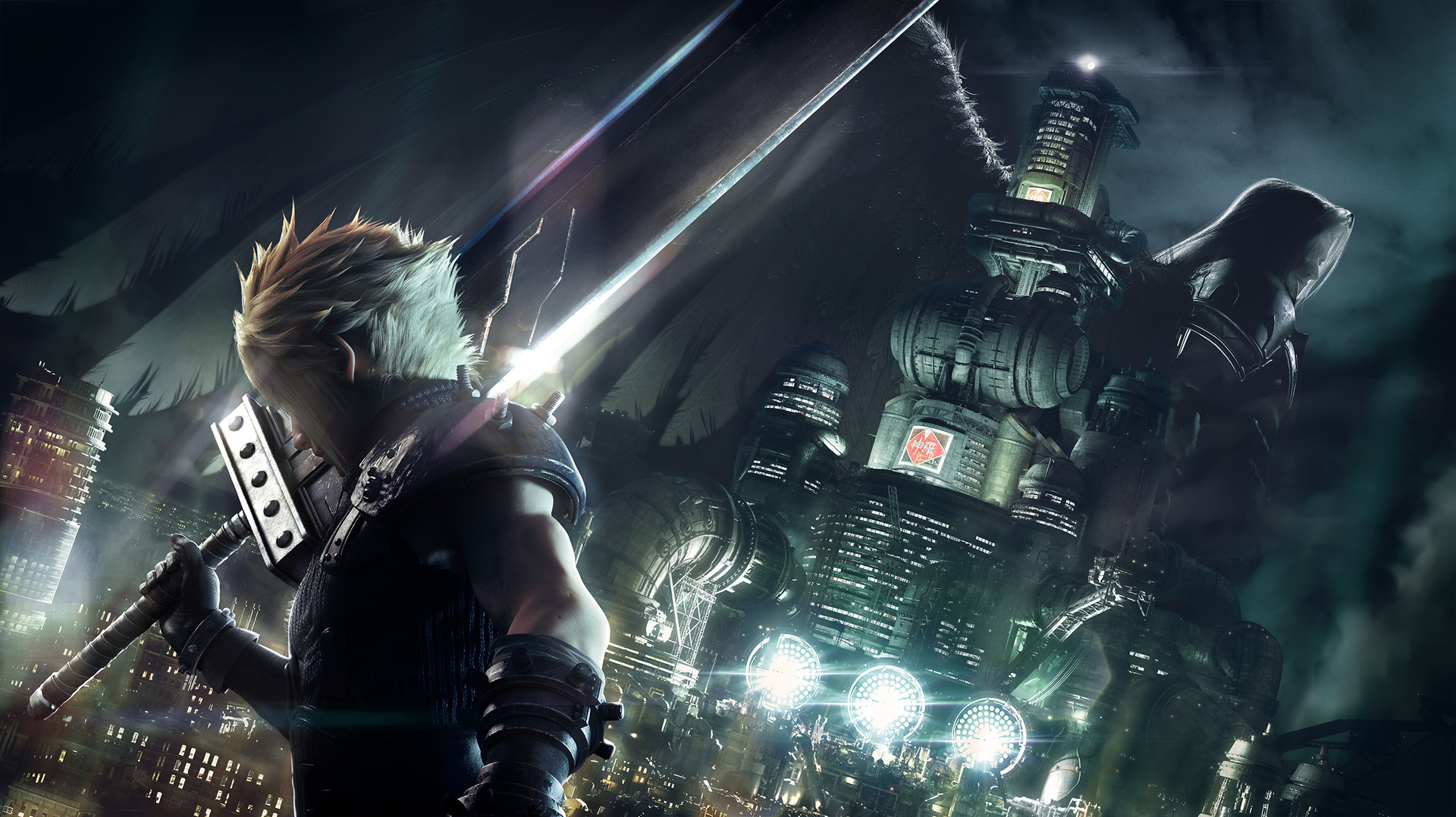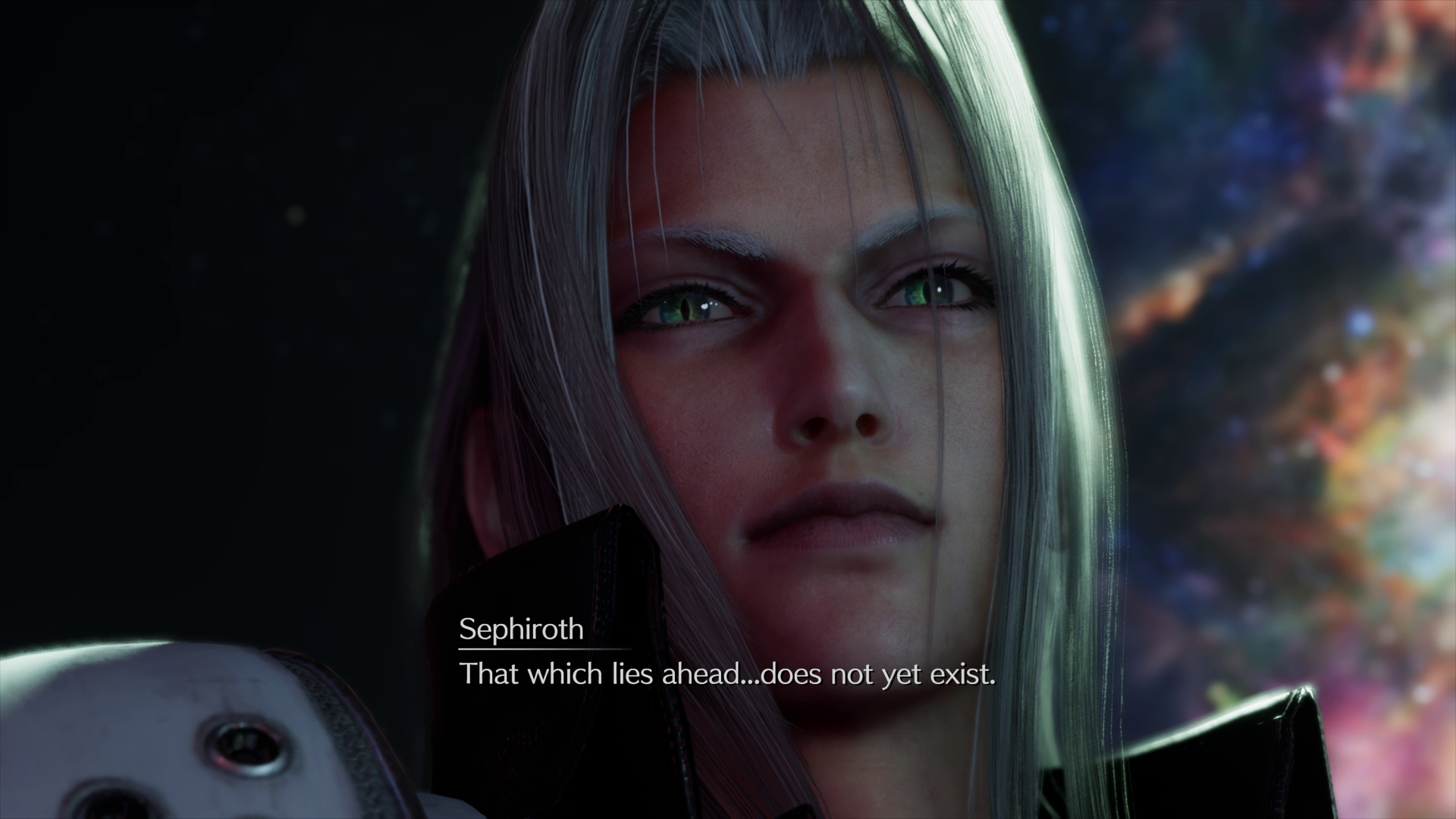Final Fantasy 7 Remake ending explained: far more than a remake
Final Fantasy 7 Remake begins as a relatively faithful recreation as a classic, but it sure takes some turns. Fans are now asking: what does it all mean?
Needless to say, this article will contain full spoilers for Final Fantasy 7 Remake. And associated spoilers for the original Final Fantasy 7. We're going to break down the ending in as much detail as we can - listing off the facts but also going deep on some speculation and deduction of what this ending might mean for this game's inevitable sequel and the world of FF7 going forwards.
Strap yourself in, as this is going to be a big one, and remember: don't read any further than this if you're not okay with spoilers. If you just want to know if the game is any good, check out our FF7 Remake review, or perhaps read our ending discussion for our immediate reaction to what was presented. On this page... we're going to try to make sense of and explain that ending. Gulp.
The role of the Whispers, the Arbiters of Fate in FF7 Remake's ending
Final Fantasy 7 Remake changes up the original FF7 story in a number of ways, but the most significant changes all involve the Whispers - strange, ghostly black-cloaked figures that appear at key moments in the story in an attempt to nudge events in the right direction. By the right direction, we mean the exact same way events play out in the original game.
When you first see the Whispers they seem harmless enough, but very quickly they begin to have a far more significant impact on events. The more events diverge away from the original FF7 storyline, the more often they appear and the more aggressive they become. On the battle for the Sector 7 Pillar, they appear to ensure Biggs and Jessie die. When Cloud, Barret and Tifa appear to have the Turks beaten to stop the plate from falling, they intervene. Later on they stop Hojo from spilling the beans about Cloud's past too early, and in their most brazen act they revive Barret when he is mortally wounded by Sephiroth simply because he wasn't supposed to die there.
Put simply, the Whispers exist to ensure events play out as ordained by destiny - and in a meta twist, the destiny of the FF7 universe is the story exactly as we saw it in the original game.
As well as escaping Midgar and Shinra, the ending of FF7 Remake involves the cast deciding to reject destiny's intentions for them and do battle with the Whispers. In battle, three more senior Whispers appear - one wielding a sword, one firearms, and one hand-to-hand. The in-game description of this trio describes them as entities "from a future timeline" that "fights to protect the future that gave shape to it".
The three choices of weapon and elemental magic are curious, as they can be matched up not only to Cloud, Tifa and Barret but also to the Advent Children antagonist group of Kadaj, Loz and Yazoo. Could it be this is future versions of some of the cast or the Advent Children characters coming back to try to preserve the timeline and protect their future?
A future changed
Once the team fights and defeats the Whispers, they have an encounter with Sephiroth - but let's skip past that for a moment and talk about what defeating the Arbiters of Fate brings around. It's a big deal, as Aerith says before the team resolve to battle the Whispers:
"I'm asking you to help me. I know that, together, we can do this. But if we do... We'll be changing more than fate itself. If we succeed... if we win... we'll be changing ourselves. I guess... maybe, that's why I hesitated."
Aerith spends much of FF7 Remake aware of the Whispers and seemingly aware of the fact that she's playing a role in a story that has already been written. Why this is we debate a little further down - but at the end of the Midgar Expressway she changes her mind. With the Whispers defeated, the future is presumably free to change - and we see a few key events have played out differently already:
- We see the people of Sector 7 rebuilding, picking up the pieces of Seventh Heaven. In the original version of the story, Sector 7 remains crushed and uninhabitable.
- Biggs is revealed to have survived the events at the plate - we see him wake up, bandaged. If Jessie is not alive, her body was at least recovered - her gloves and headband are on Biggs' nightstand. Wedge's status remains unknown.
- Zack Fair, Cloud's mentor, is seen to survive an encounter with Shinra soldiers that in the original FF7 and Crisis Core saw him die, itself a key part of Cloud's journey.
Each time we see one of these scenes revealing a significantly changed future, we see sparkles in the sky, scattering like snow to the ground. This sparkles appear when the Whispers explode out of existence - suggesting that the sparkles will appear anywhere that the Whispers were at work trying to manipulate events and preserve the timeline.
While there are two different versions of Zack's demise - one depicted in the original FF7 and another as the ending of Crisis Core that later superseded the original scene - this outcome matches neither. It starts out looking like the Crisis Core scene, but Zack ultimately triumphs. Even he appears surprised at his survival - and the final shot of the game sees Aerith seemingly recognize what has happened - that Zack, the old boyfriend she mentions in the course of FF7 Remake, is now alive.
There's one more thing in this scene that's curious, however. Take a look at this:
Above are two screenshots of FF7 Remake. One is from chapter 4, where the Avalanche members visit Jessie's parents' above the plate. The second is from the ending scene where Zack is revealed to have survived. As part of that scene, this empty packet is blown in front of the camera by the wind, but the scene takes a moment to linger and focus on it, as if it's important. The packet depicts Stamp, the cute cartoon dog used as Shinra military propaganda. So why focus on the litter in Zack's dramatic survival?
Well, look closer. The stamp you see throughout FF7 Remake is one design and breed of cartoon dog, while this one is another. Further, it's not just something that's only on the 'Stamps Champs' snack packet - as we see packets of these with the 'correct' Stamp throughout FF7 Remake, including here on the table in Jessie's parents' home.
So, what does this signify? Well, it suggests that one of two things has happened: either Zack's survival occurred in a parallel, alternate universe where among other things the Stamp design is different. Or, the changes to the past, present and future caused by defeating the Whispers has caused many ripples through time, including a change to Shinra's military mascot.
Regardless, there is now one paradox: unless Zack dies somewhere in the interim between his new survival and the start of FF7 Remake (his death or survival takes place years earlier), there are at the very least two Buster Swords: originally, Cloud is bequeathed his weapon by Zack in his final moments. Could a sequel also see you playing as Zack? Time will tell, but the point is clear regardless of the exact details: the world has changed significantly, and so subsequent chapters of FF7 Remake can deviate from the original story more dramatically if that's what the writers desire.
It's all about Sephiroth
Before we get on to the nitty gritty of Final Fantasy 7 Remake's ending, there's something important to understand. While this is speculation and inference, we are confident it is correct -- it appears that the Sephiroth we see throughout FF7 Remake isn't some new version of the character in line with the alternate takes on the likes of Cloud and Barret in FF7 Remake. Rather, it's certainly a Sephiroth from the future and is likely a Sephiroth we have seen before - specifically and crucially the one that fans watched Cloud defeat in FF7 sequel movie Advent Children.
The first clue of this appeared all the way back in the original key artwork released for the game. You can see it above. FF7 fans might notice something off about Sephiroth - but it's something subtle enough that at that time most thought little of it. Sephiroth has a black wing.
In the original Final Fantasy 7, the flesh and blood Sephiroth has limited presence. By the time you fight him, he's taken on the demigod form of Bizarro Sephiroth and then the multi-winged Safer Sephiroth. The iconic One-Winged Angel musical cue is named for Safer Sephiroth, who has one dark wing extending from the right-hand side of his body, as well as a whole bunch of white wings replacing his legs. The main point is this: in the original FF7, Sephiroth never sports a wing in his human form. This is important.
Once we see Sephiroth in Advent Children, he descends from the skies with a huge black wing, a hangover from his time as a god in FF7's conclusion. This Sephiroth is still hugely powerful, displaying those godly abilities by completely changing the environment around him and generally being hugely powerful. When defeated, Sephiroth practically promises to return, vowing "I will never be a memory." All of this, again, is significant.
So, we're saying that the Sephiroth that appears to you in Final Fantasy 7 Remake isn't a new one - it is the very same Sephiroth from the original Compilation of FF7, travelling through time and universes in the wake of Advent Children. But where's the evidence? Well... it's in the game.
The black wing is the first and most obvious piece of evidence, but it isn't alone. In the intro movie, we see Aerith looking at a leak of Mako energy in an alleyway, just as in the original game. But the music takes an ominous tone and we hear Latin chanting that translates to "Burning inside, with violent anger", the first lines of One-Winged Angel. This repeats a couple of times - and though it could simply be a nod to the grander threat, specifically using the theme that in the original FF7 Sephiroth doesn't gain until he becomes a god and transcends his human form seems notable when taken alongside the rest of the evidence.
In the first chapter of the game, Cloud has a minor episode before planting the bomb in Mako Reactor 1. This freak-out is present in the original game, but one thing has changed - Cloud sees a black feather, which then disappears. In chapter 2, Cloud has his first encounter with Sephiroth. As well as significantly changing the story, this encounter is followed by a very curious choice of musical cue: a new version of 'The Promised Land' from Advent Children, almost as if to herald the appearance of the AC version of Sephiroth. This is the only use of an Advent Children exclusive music piece in the game.
In general, the Sephiroth we get in FF7 Remake matches up more with the one from Advent Children than the original game. The final battle greatly resembles their showdown in Advent Children, right down to the moves used by Sephiroth and the environments he creates. In the original game Sephiroth is initially more concerned with his own grand plans and doesn't regard Cloud as anything significant. This changes over time, and by the time we reach Advent Children Sephiroth is practically obsessed with tormenting and hurting Cloud. It's this version we get in FF7 Remake, constantly taunting and smirking.
It's a Remake - but it's also a Sequel
The final scene of the game with Sephiroth is key. In a scene deliberately built to mirror the original final showdown between Cloud and the villain in the original game, the pair briefly spar. Cloud is going for it, without doubt trying to kill Sephiroth - while he remains cool, calm and collected, clearly holding back and not trying to kill Cloud. More interesting than the fighting, however, is what is said.
"That which lies ahead does not yet exist," Sephiroth says, reaffirming the newly open future created by the defeat of the Whispers. "Let us defy destiny together," he goes on to say, urging Cloud to join in him creating a new future. Cloud naturally refuses.
This makes plain this Sephiroth's goals: he has lost - twice now - and has traveled both back and across universes in order to try to create a timeline and universe where he is victorious. His ultimate goal, as before, is to walk in Jenova's footsteps, conquering the planet, turning it into a vessel to travel through the cosmos to wreak universal destruction.
This being possible doesn't seem like a huge stretch, as it is well-established in FF7 lore that certain powerful beings can live on with a sense of consciousness in the lifestream after death. In Advent Children, the dead Aerith talks to Cloud, reaches out to a dying Kadaj and even reunites with Zack inside the lifestream. The entire plot of Advent Children is driven by the Geostigma, a disease caused by the presence of Jenova and Sephiroth inside the lifestream.
In FF7 Remake it is established that history and destiny as we know it is "the will of the planet itself" and "the flow of the planet from inception to oblivion", as described by Red XIII. We know the Lifestream connects and binds all things in the world of FF7 - so it makes sense that the Lifestream could be used as a vessel to travel between different time periods and universes.
This ability can also explain Aerith's knowledge. Throughout FF7 Remake's story she appears to know more than she lets on. She knows, for instance, that Marlene is Barret's daughter without ever being told. Throughout chapter 10 and 11 when Tifa doesn't quite believe Shinra would drop the plate, Aerith seems to already know what is about to happen. The Whispers are focused on her, and when other characters touch her - like Marlene and Red XIII - they appear to gain knowledge of the future. Could it be the Remake version of Aerith has been convening with the spirit of the original and been told of what is to come? Ancients speaking to their ancestors and the planet is a well-established fact - so again, it isn't a huge leap.
At the end of FF7 Remake the party is still heading out from Midgar into the wider world, but the parameters have shifted. If the hypothesis of this being a later Sephiroth attempting to change his fate ring true, what of the Remake world's original Sephiroth that should for now still be inside the Northern Crater? Also, given that Sephiroth's goal seems to involve changing the future, has the party simply played into his hands by defeating the Whispers? They could - and arguably should - go wild in the next game. Only time - and sequels - will tell.









